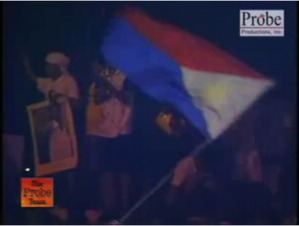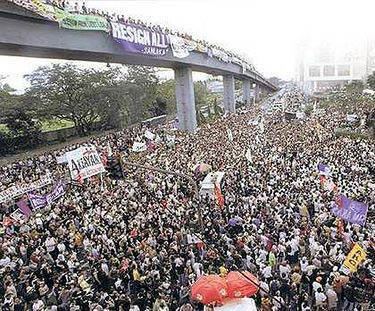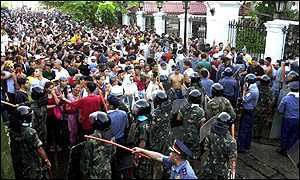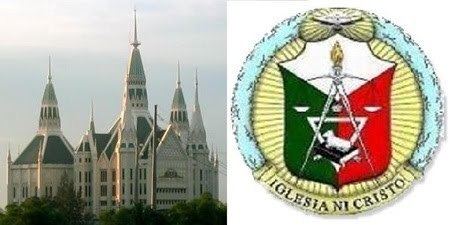Dates 30 Apr 2001 – 1 May 2001 Method Protest | ||
 | ||
Result Violent dispersal of protesters; declaration of a state of rebellion and arrest leaders of the opposition. Similar People Power Revolution, 2014 Burkinabé uprising, Oakwood mutiny, 1989 Philippine coup atte, Rose Revolution | ||
The May 1 riots or EDSA Tres was a protest sparked by the arrest in April 2001 of newly deposed President Joseph Estrada of the Philippines. The protest was held for seven days in a major highway in Metropolitan Manila, the Epifanio de los Santos Avenue or EDSA, which eventually culminated in an attempt to storm the Malacañang presidential palace. Taking place four months after EDSA Revolution of 2001, the protests were asserted as a more populist and representative uprising in comparison to the previous demonstrations in the same location, in January 2001. The protests and the attack on the presidential palace, however, failed in their objectives. Participants continue to claim that it was a genuine People Power event, a claim disputed by the participants and supporters of EDSA II. President Gloria Macapagal-Arroyo has acknowledged the divisive nature of the two terminologies by saying in one statement that she hoped to be the president of "EDSA II and EDSA III."
Contents

April 30

The crowd of an alleged several hundred thousand people (although according to Eagle Broadcasting Corporation-owned broadcast network Net 25 and to Senator Sotto, a high of over 3 million in the evening of April 30), most of whom were members of the urban poor and devotees of the Iglesia ni Cristo which institutionally supported Estrada, gathered at the Roman Catholic EDSA Shrine, the site of the January EDSA II revolt which had toppled Estrada from the presidency.

News organizations aiming to cover the rally were advised not approach the area, as there were reports of stones being thrown at cameramen, particularly those from ABS-CBN.

The protest was led by members of the political opposition of the time, most notably Senators Juan Ponce Enrile, Vicente Sotto III, Gringo Honasan, Panfilo Lacson and Miriam Defensor-Santiago.
May 1

The rebellion aimed to remove Gloria Macapagal-Arroyo from the presidency and to reinstate Estrada. The rebellion came to a head on the morning of May 1, 2001 most of the people left specially the Iglesia ni Cristo members as an agreement of their leaders and the government. Still hundreds of thousands of protesters stormed towards Malacañan Palace, the presidential residence; government soldiers and the policemen dispersed the marchers, causing violence. Several broadcast vans of ABS-CBN were torched by members of the crowd, while others attacked the police and soldiers with rocks, sticks, and pipes. The police and military responded with force after implementing a "maximum tolerance" policy, which led to the injury of many of the protesters. President Arroyo declared a State of Rebellion in the National Capital Region pursuant to Proclamation No. 38 and arrested leaders who participated in the said rebellion like Senator Juan Ponce Enrile but released on bail. On May 7, 2001, President Arroyo lifted the State of Rebellion.

Hours after the crowds of EDSA III were dispersed, representatives of the Archdiocese of Manila and Civil Society supporters of the Arroyo administration reclaimed the EDSA Shrine where there had been alleged acts of vandalism and garbage everywhere and the vicinity reeked with the strong smell of human waste. Since this protest was carried out mostly by the lower income, uneducated masses, widespread destruction and vandalism of public utilities (stop lights and street posts where thrown down) crew cab of ABS-CBN were burned down and public stores fronting along the protest routes at Claro M. Recto Avenue, Legarda Avenue, Chino Roces (Mendiola Street), Rizal Avenue, Nicanor Reyes (Morayta Street) and Quezon Boulevard. Most of those arrested were later set free. As for the public figures that supported the rallies, they abandoned them and shied away at its most critical time when it became obvious, that unlike the previous administrations, the Arroyo administration was not backing down from this latest people power styled protest which it perceived was political manipulation which resulted in mob mentality and anarchy of the masses urged by its political opponents.
Critics of EDSA Tres, styled after the People Power Revolution (EDSA Revolution) and EDSA Revolution of 2001, argue that while this was a major protest, the spirit of it was unlike of the first and second protests. Supporters of Edsa Tres journalism allege that EDSA's I and II's participants were made up of the middle and upper classes and thus, not democratically-representative unlike those who participated in EDSA Tres. Other arguments also point to the success of the first two to remove the presidents targeted, versus this event's failure to do so.
